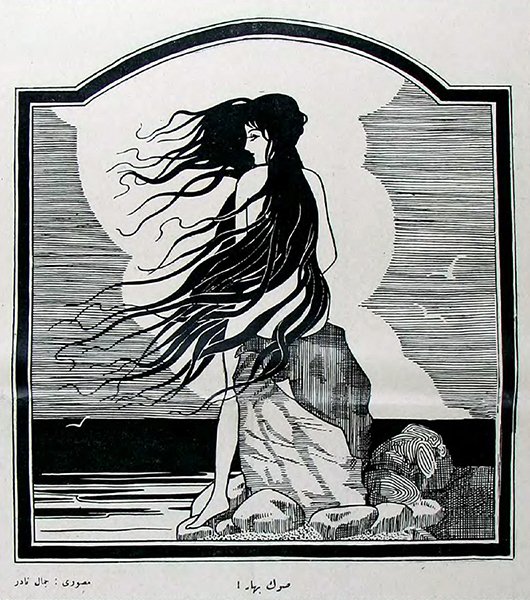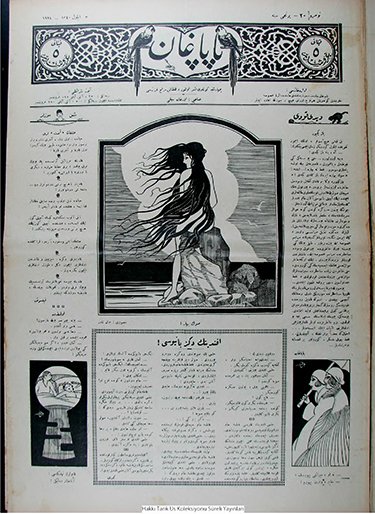109. Today in 1920s Turkey: 3 September 1924 (Autumn au Naturel)

(Cartoon by Cemal Nadir Güler, Papağan or “Parrot,” 3 September 1924, no. 20, page 1.)
Türkçe: Sonbahar!
English: Autumn!
Comments:
The main cover picture for this week’s issue of the journal, Papağan or “Parrot” represents a personification of Autumn. This particular “meaning” is not immediately obvious from the image which is perhaps why, for clarification, the declaration “Autumn!” (Sonbahar!) was included below the image. The caption thus provides a frame with which to consider the otherwise naturally subdued image. Now it is possible to view it as somewhat melancholy—perhaps the calm before a storm.
The scene itself presents a lone, nude woman perched upon a rocky outcrop off the coast of a beach. The picture benefits from a strong graphic line and bold color blocks. At the very center is the woman who is seated with her back turned to the reader with her head turned to the left, thus visible in profile. Strategically placed cascades of long, black hair interrupt much of her otherwise white, nude body. Concealing Autumn’s body with her own locks was not merely a strategic choice but an aesthetic one too. The sinuous tentacles of hair are almost entirely reverse-framed by the white cloud splitting the background of the picture. This use of contrasting colors creates balance in the composition and aids in focusing the reader’s attention to the central figure.
Of course, Autumn is not only represented in the figure but the entire composition projects the coming of a new season. As an intermediary season between the heat of summer and the cold of winter, Autumn represents change and the unexpected. The woman’s condition is similar in that she is both nude and concealed. Her arms are placed close to her torso suggesting colder weather or (less literally) a more melancholy mood. The cloud overhead not only serves an aesthetic purpose but it also contributes to the Autumn theme as a harbinger of the new, less welcoming weather conditions ahead.
Papağan or “Parrot” was a weekly journal that ran between 1924 and 1925. It often featured rather risque images of woman both on its cover and between its pages. The present image is a good example of the kinds of images one may find in this paper. While some are rather crude, others are quite sophisticated and deliver very satisfying and aesthetically appealing content such as that of “Autumn.” As the first September issue of the magazine, this personification of Autumn serves to welcome the arrival of the first month in such a beautiful composition perhaps in order to distract readers from the sad reality of the seasons changing and the once active and sunny beaches becoming desolated, cloudy, and dark. The carefree days of summer are coming to an end and she (like many people) is about to bid farewell to it until next year.

(Entire page, Papağan or “Parrot,” 3 September 1924, no. 20, page 1.)
I love the emotion you captured here! The deeper meaning really spoke to me and that takes a lot of talent to attain!
Thanks @granegvesky ! Writing about images help me focus to see things that otherwise may escape my attention. Counter-intuitively, I've found that it can be a great way to "look" at and process images.
Really touching article!
Thank you @markosky . The weather has changed here, so I'm feeling the same sentiments, too.
Yes I know what you mean! :) But in the recent years I like that melancholy weather. It inspire's me :)
I can see that: the changing of seasons is dramatic and uncontrollable. It reminds us of time's passing...
Somehow it reminds me of ottoman minatures and ancient chinese paintings. I have to admit there are a lot of differences also but that long hair along the wind reminds me those.
Your eyes are not deceiving you! There are a whole series of illustrations from the 1920s in Turkey that resemble Ottoman miniatures except filtered through an Art Nouveau lens... and the Art Nouveau movement was heavily inspired by the East, including Japanese prints and Chinese porcelain design. So if you're seeing Ottoman and Chinese elements you are absolutely spot on:)
I knew it!! Mixture of that knowledge resulted a beautifully unique work. I can't say that it is eastern or western at first look.
You're right. This is a good example of how eclecticism can create brilliantly innovative results: creating something new yet familiar...
Additionally, these more poetic works by this particular artist are relatively unknown (usually his later work is celebrated). So it adds a new dimension to Cemal Nadir's known oeuvre.
This post has been modified, updated, and re-posted on 3 September 2018. Access the new edition here.